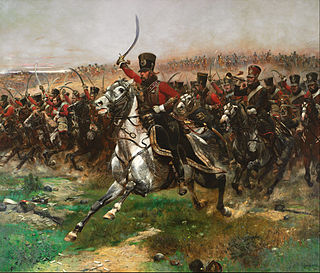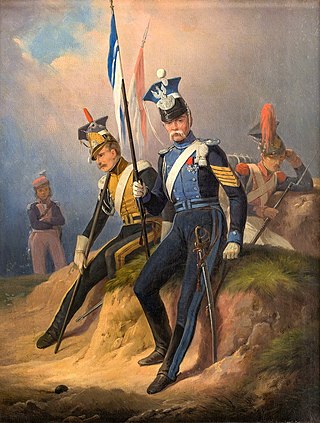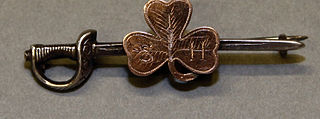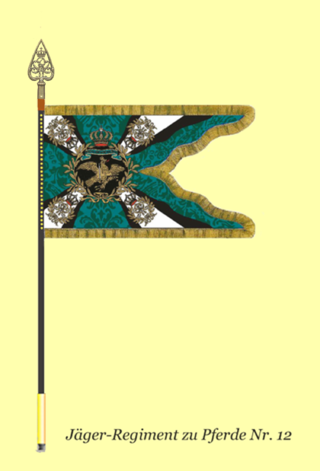Related Research Articles

Historically, cavalry are soldiers or warriors who fight mounted on horseback. Cavalry were the most mobile of the combat arms, operating as light cavalry in the roles of reconnaissance, screening, and skirmishing in many armies, or as heavy cavalry for decisive shock attacks in other armies. An individual soldier in the cavalry is known by a number of designations depending on era and tactics, such as cavalryman, horseman, trooper, cataphract, knight, drabant, hussar, uhlan, mamluk, cuirassier, lancer, dragoon, or horse archer. The designation of cavalry was not usually given to any military forces that used other animals for mounts, such as camels or elephants. Infantry who moved on horseback, but dismounted to fight on foot, were known in the early 17th to the early 18th century as dragoons, a class of mounted infantry which in most armies later evolved into standard cavalry while retaining their historic designation.

Dragoons were originally a class of mounted infantry, who used horses for mobility, but dismounted to fight on foot. From the early 17th century onward, dragoons were increasingly also employed as conventional cavalry and trained for combat with swords and firearms from horseback. While their use goes back to the late 16th century, dragoon regiments were established in most European armies during the 17th and early 18th centuries; they provided greater mobility than regular infantry but were far less expensive than cavalry.

Uhlans were a type of light cavalry, primarily armed with a lance. While first appearing in the cavalry of Lithuania and then Poland, Uhlans were quickly adopted by the mounted forces of other countries, including France, Russia, Prussia, Saxony and Austria-Hungary.

A lancer was a type of cavalryman who fought with a lance. Lances were used for mounted warfare in Assyria as early as 700 BC and subsequently by Persia, India, Egypt, China, Greece, and Rome. The weapon was widely used throughout Eurasia during the Middle Ages and the Renaissance by heavy cavalry, but fell out of general use in the late 16th century before its revival by light cavalry in the 19th century.

The Queen Nandi Mounted Rifles is an reserve armoured regiment of the South African Army.

The Indian Army was involved in World War I via the British East India Company. Over one million Indian troops served overseas, of whom 62,000 died and another 67,000 were wounded. In total at least 74,187 Indian soldiers died during the war.

The 2/4th Chasseurs à Cheval Regiment was a cavalry regiment in the Land Component of the Belgian Armed Forces. The regiment was the armoured reconnaissance regiment of the Motorized Brigade.
The 3rd (Lahore) Division was an infantry division of the British Indian Army, first organised in 1852. It saw service during World War I as part of the Indian Corps in France before being moved to the Middle East where it fought against troops of the Ottoman Empire.

The South Irish Horse was a Special Reserve cavalry regiment of the British Army. Formed as an Imperial Yeomanry regiment in 1902 as the South of Ireland Imperial Yeomanry, it perpetuated a unit formed during the Second Boer War. It transferred to the Special Reserve (Cavalry) in 1908 and was renamed as the South Irish Horse. Having taken part in the fighting of World War I, it was disbanded after Irish Independence in 1922.
The 4th Mounted Rifles were a light cavalry regiment of the Royal Prussian Army. The regiment was formed 1 October 1906 in Graudenz.
The 5th Mounted Rifles were a light cavalry regiment of the Royal Prussian Army. The regiment was formed 1 October 1908 in Mülhausen in Elsaß.

The 6th Mounted Rifles were a light cavalry regiment of the Royal Prussian Army. The regiment was formed 1 October 1910 in Erfurt.
The 7th Mounted Rifles were a light cavalry regiment of the Royal Prussian Army. The regiment was formed 1 October 1913 in Trier.
The 8th Mounted Rifles were a light cavalry regiment of the Royal Prussian Army. The regiment was formed 1 October 1913 in Trier.
The 9th Mounted Rifles were a light cavalry regiment of the Royal Prussian Army. The regiment was formed 1 October 1913 in Insterburg.
The 10th Mounted Rifles were a light cavalry regiment of the Royal Prussian Army. The regiment was formed 1 October 1913 in Angerburg.
The 11th Mounted Rifles were a light cavalry regiment of the Royal Prussian Army. The regiment was formed 1 October 1913 in Tarnowitz.

The 12th Mounted Rifles were a light cavalry regiment of the Royal Prussian Army. The regiment was formed 1 October 1913 in St. Avold.

The 13th Mounted Rifles were a light cavalry regiment of the Royal Prussian Army. The regiment was formed 1 October 1913 in Saarlouis.
The 26th Dragoons “King”(Dragonerregiment „König“ Nr. 26) was a cavalry regiment of the Army of Württemberg. The regiment was originally formed in 1805 as Mounted Rifles but reorganized as dragoons in 1870. In 1891 it was named after Prince William, then Crown Prince, and renamed King upon his accession to the throne as William II of Württemberg. The regiment took part in Napoleon's Russian campaign and fought in the Austro-Prussian and the Franco-Prussian wars and was part of the 7th Cavalry Division in World War I. On 1 May 1919 the regiment was disbanded, with 4th Squadron/18th Horse bearing its tradition in the new Reichsheer.
References
- Schulz, Hugo (1992). Die preussischen Kavallerie-Regimenter 1913/1914 nach dem Gesetz vom 3. Juli 1913. Augsburg: Weltbild. pp. 172–173. ISBN 3893503439.